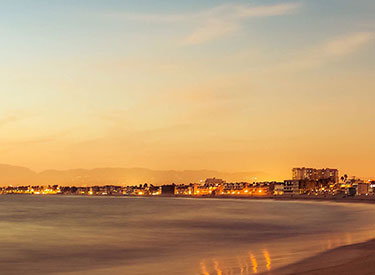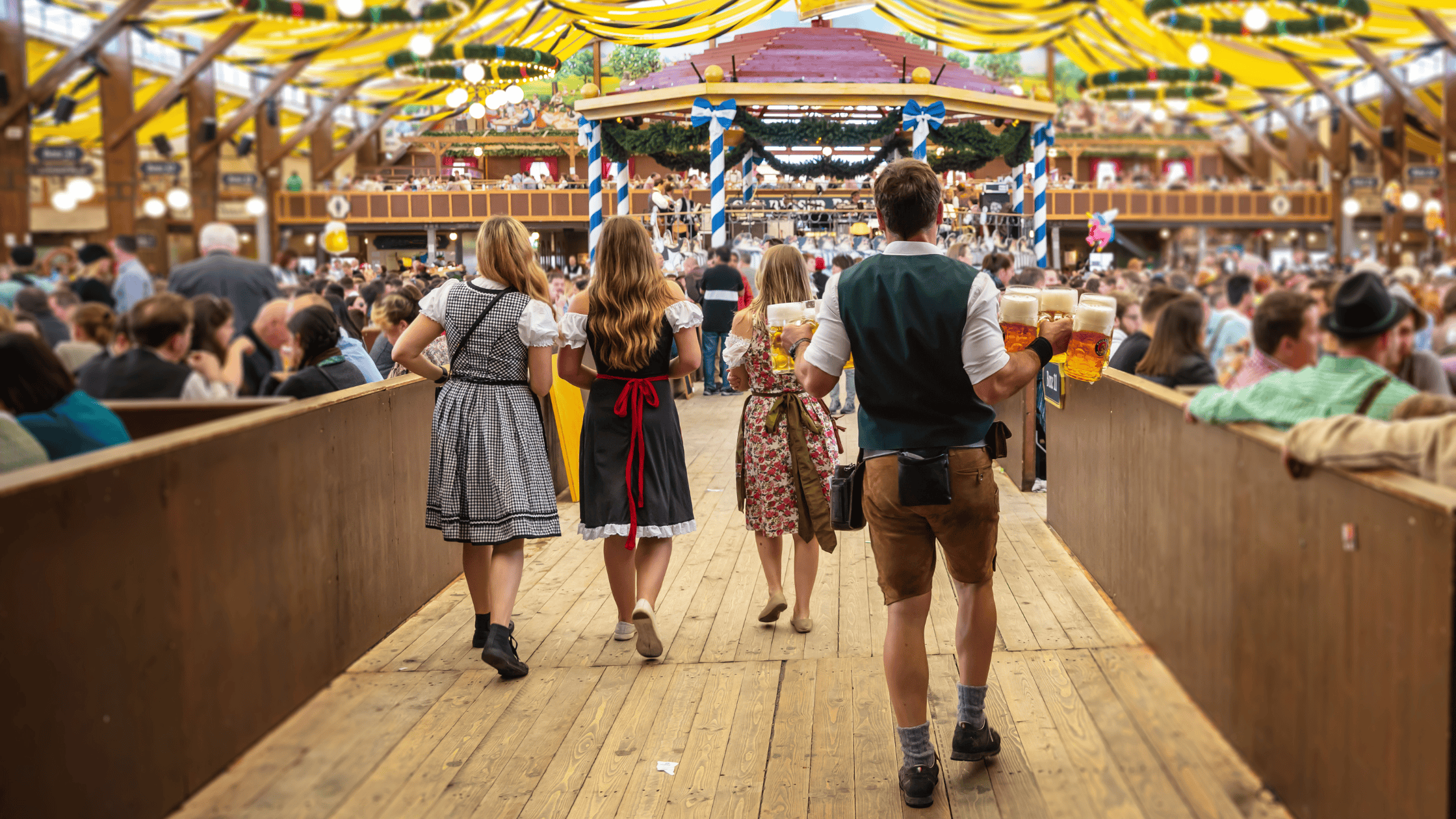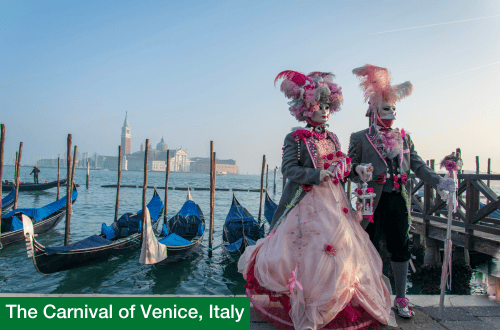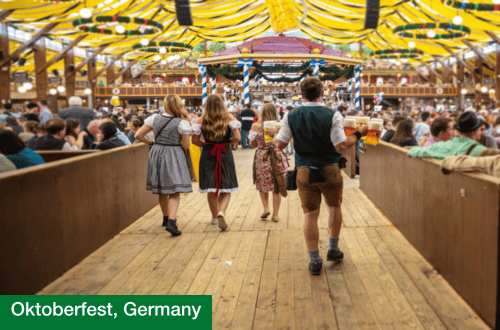


Festivals can teach us a lot about a country and its people, from history and traditions to culture and cuisine. Many of Europe’s greatest festivals and cultural events are celebrations of centuries-old tradition and heritage, while others are delightfully quirky and utterly original. These are eight of our favourite European cultural festivals and events throughout the year:

The Carnival of Venice (Carnevale di Venezia) originated in twelfth century with the celebration of an important military victory by the Venetian Republic. Although it existed in various guises over the following centuries, it became a major event on the modern-day Venetian event calendar in the 1970s, when the Italian government decided to create a showcase of Venetian musical and artistic heritage.
The carnival is held over the ten days that lead up to the Christian period of Lent. You can enjoy the endless procession of masquerade parties, parades and gala balls as well as concerts and street performances. Join the crowds who gather in St Mark’s Square (Piazza San Marco) to witness theatrical highlights such as the Flight of the Angel and the Flight of the Lion.
From the elaborately decorated masks traditionally worn by Carnival revellers, to the mouthwatering selection of Venetian treats on offer (we particularly recommend sampling fritole and galani), Carnival is a chance for you to take part in a colourful, vibrant celebration of creativity and history in one of the world’s most beautiful cities.
St. Patrick’s Day is celebrated all over the world, but there’s something special about experiencing this holiday in the heart of the Irish capital. Although the holiday falls on 17th March every year, Dublin hosts a variety of associated events in the lead-up to the big day, from céilís and concerts to an artisan food festival that showcases the finest in Irish cuisine.
The highlight of the holiday is undoubtedly Dublin’s St Patrick’s Day parade, during which an estimated half-million spectators line the 2.5-kilometre parade route. Don your finest green and join the crowd to watch around 4,000 parade participants, dressed in extravagantly colourful costumes, march through the through the city. Although you can enjoy the parade for free, it’s a good idea to pre-book a spot on one of the grandstands that line the route – the parade begins at 12pm and lasts around two hours, but the party lasts a lot longer!
Celebrated on 27th April every year since Willem-Alexander ascended the throne as King of the Netherlands in 2013, this national holiday is your invitation to join the fun of what may be Europe’s biggest birthday party. For many people, the celebrations start the night before the actual holiday, on ‘King’s Night’ (Koningsnacht), while Koningsdag itself is marked by a variety of festivities across the country.
Amsterdam is party central for King’s Day: the streets and canals are packed with happy revellers enjoying the live music, parties and fun fairs, and browsing the iconic King’s Day flea markets. The Dutch Royal Family is known as the House of Nassau-Orange, which is why the dress code for King’s Day is orange, orange and more orange. Keep an eye out for street vendors selling the classic orange-infused pastries known as tompouce, and be sure to toast the King’s health with a glass of Oranjebitter or Aperol Spritz.
Europe offers more than a few options if you like your festivals slightly eccentric, but there are few to rival the sheer lunacy of the Cooper’s Hill Cheese Rolling and Wake. The event is a mad-cap exhibition of what happens when gravity meets a large wheel of cheese on a steep, grassy slope in the English countryside, and competitors are invited to give chase.
The result is a spectacle of speed, agility and fearlessness, in which runners attempt to determine whether it’s possible to descend a 180-metre slope faster than a bouncing four-kilogram wheel of Double Gloucester. Given the number of injuries sustained by competitors over the years, we recommend taking in the fun purely as a spectator. What’s more, a hearty ploughman’s lunch at a nearby village pub is a far less hazardous way to enjoy your cheese.
It’s not entirely clear how it all started, but one thing is for certain: La Tomatina is quite possibly the most epic food fight anywhere in the world. On the last Wednesday of August each year, 20,000 people arrive in the tiny village of Buñol near Valenica to take part in the chaos and fun of a fiercely fought battle using tomatoes as ammunition.
To begin, a ritual known as the Palo Jabón requires that someone successfully scales a tall, greased pole to retrieve a large ham from the top. Task complete, the firing of a water cannon signals the beginning of the fight itself, and then a convoy of immense trucks rumbles through the narrow streets, delivering 120 tonnes of tomatoes for you to hurl at random strangers. After an hour, a second water cannon is fired, fire trucks arrive to hose down the white buildings which line the streets, and you and your fellow combatants – now a fetching shade of vermillion – can head to the river to rinse off as much pulp as possible.
You will need to pre-purchase your ticket to be a part of La Tomatina, and it’s well worth adding entry to the festival after-party so you can swap war stories with your new comrades over a jug of sangria. We recommend choosing Valencia as your home base as there are plenty of accommodation options and it’s only a short train journey away from Buñol.
The German capital city is one of Europe’s great cultural and artistic destinations, offering a diverse and dynamic mix of music, art, architecture and performance. Since 2005, one of the highlights of Berlin’s cultural calendar has been the vibrant Festival of Lights, which runs for ten days every October. It’s a chance to see Berlin’s most iconic buildings, squares and monuments, from the Brandenburg Gate to the city’s Cathedral, illuminated and transformed into vibrant masterpieces by artists from around the world.
Every year the festival has a different theme: in 2024, the festival will celebrate its twentieth anniversary with the theme, “Celebrating Freedom”. Entry is free, but you may prefer to upgrade your experience with a guided walking tour or hop-on, hop-off tour of the participating landmarks.

From mid-September until the first Sunday in October, the German city of Munich hosts around six million locals and visitors for the world’s largest celebration of beer. There are 17 large and 21 small beer tents to choose from, each one serving up great Bavarian beer and hospitality along with traditional folk music, enthusiastic singing and dancing, and delicious local cuisine.
The tradition of Oktoberfest dates back to the early nineteenth century, when Crown Prince Ludwig of Bavaria invited the citizens of Munich to an open-air celebration of his marriage to Princess Therese of Saxe-Hildburghausen. The meadow where this immense party took place became known as Therese’s Meadow (aka Theresienwiese, or d’Wiesn for short), which the space remains the epicentre of Oktoberfest celebrations to this day. As well as the famous beer tents, you’ll find traditional fairground attractions ranging from rollercoasters and merry-go-rounds to photo booths and a Ferris wheel that offers incredible views over d’Wiesn and the wider city.
Although Munich is the OG location for Oktoberfest, you can experience variations on this celebration of Bavarian culture and cuisine around the world, from Brazil to Hong Kong.
Every year, Edinburgh hosts one of the world’s largest and most memorable New Year’s Eve celebrations, set against the spectacular backdrop of Edinburgh Castle. Around 40,000 people flock to the city’s Princes Street to enjoy the official Street Party: a feast of entertainment including live music and street performers, along with an array of street food and outdoor bars. Concert in the Gardens is a key component of Hogmanay celebrations in the city: this ticketed event in West Princes Street Gardens typically features a headline live music act which sets the party mood for the countdown to midnight.
It’s impossible not to be caught up in the festive atmosphere, as strangers join hands for a rousing rendition of Auld Lang Syne, accompanied by spectacular fireworks display that lights up the night sky high above the ancient castle walls.
These unique and quirky festivals are a fabulous way to experience a destination’s distinct character and heritage. To add a touch of festival flair to your next European holiday, talk to your personal travel manager.